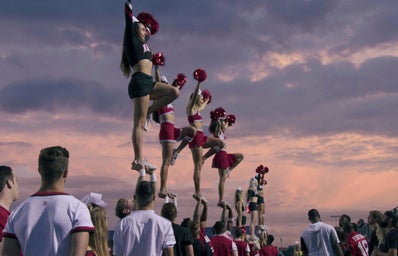Cheerleaders have been portrayed as pretty, mean girls in movies and TV shows for decades. They’re always wearing their uniforms and are usually more concerned with their popularity than their school work. The team captain starts catty fights with her teammates and almost always choreographs overly sexual dances that involve minimal real cheer moves.
As a former cheerleader, I am frustrated by these awful stereotypes. When I tell people that I cheered, they usually make comments like “but you’re smart” or “you don’t seem like a cheerleader.” People have these misconceptions about cheerleaders because of movies like Bring it On (or really any TV show about high school students with cheerleaders). It’s difficult to convince people that cheerleading is a physically demanding and intense sport when there really hasn’t been any media portraying the hard work that goes into cheering. Yes, we wear skirts, bows, and makeup, but we also throw people 10 feet into the air and bend our bodies in ways that most humans cannot. Cheerleading hadn’t gotten the real recognition that it deserves until the Netflix docuseries Cheer debuted in January.
Cheer follows a select number of squad members on the fourteen-time national championship team, Navarro, and each of them have heartbreaking stories. Jerry, the uplifting, positive light on the team, lives with the family of his teammate after his mom passed away from cancer. Morgan was abandoned in a trailer by her father when she was just starting high school and was taken in by her grandparents. Each member has a different story, but they all put their hearts and souls into the sport of cheerleading.
Monica is the intelligent and determined coach in charge of the Navarro cheer squad and many of her cheerleaders would jump in front of a train for her. She is the supportive parental figure that many of her athletes never had growing up. She sets a great example of checking in on people and caring about the human behind the athlete. Cheer reminds the world that championships don’t come without struggle. It’s easy to see the fourteen championships and think the athletes must have perfect lives, but in reality they don’t. As the old saying goes, don’t judge a book by its cover.
Cheer also reiterates the sad reality that cheerleading is a sport with no career opportunities after college. NFL cheerleaders are not cheerleaders, they are professional dancers who get paid next to nothing which is a whole other issue. It’s heartbreaking to watch the Navarro cheerleaders break their bodies for a sport that they can’t do post-college. During one of the episodes, Morgan’s grandparents suggest she open a nail salon post-graduation since she has nail art talent. The reality is, her flexibility and willingness to be thrown high into the air won’t be too useful once she stops cheerleading. Other cheerleaders on Navarro apply to four-year colleges to get their bachelors degrees and continue cheering for a few more years. While there may not be any cheerleading career opportunities, it’s clear that every squad member loves the sport and it’s addicting to watch the trials and triumphs of this team.
At the end of the day, we all need to be a little more like Jerry and ‘mat-talk’ our friends and family through their struggles. Mat talk is simple hyping up, encouraging, and cheering on a teammate and this kind of encouragement definitely extends out of cheerleading and into life. A positive attitude can really make all the difference.
Oh, and can we settle the long debated question of “is cheerleading a sport?” once and for all? Hell yeah!


